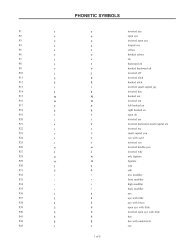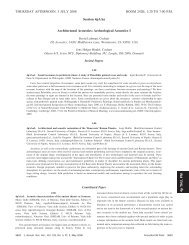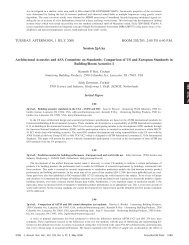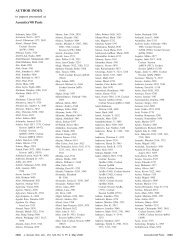Tuesday afternoon, 11 November - The Acoustical Society of America
Tuesday afternoon, 11 November - The Acoustical Society of America
Tuesday afternoon, 11 November - The Acoustical Society of America
Create successful ePaper yourself
Turn your PDF publications into a flip-book with our unique Google optimized e-Paper software.
oth for daytime resting behavior and night-time foraging. <strong>The</strong> recordings<br />
also provide a measure <strong>of</strong> vessel traffic at locations important to spinner<br />
dolphins. Combined, these data demonstrate the value <strong>of</strong> passive acoustic<br />
methods for monitoring cetacean populations and their habitat over extended<br />
periods.<br />
3:55<br />
2pAB8. Temporal and geographic patterns in the occurrence and<br />
distribution <strong>of</strong> minke whale (Balaenoptera acutorostrata) boings in the<br />
central and western North Pacific. Julie Oswald Hawaii Inst. <strong>of</strong> Marine<br />
Biology, Univ. <strong>of</strong> Hawaii, 46-007 Lilipuna Rd., Kaneohe, HI 96744,<br />
jnoswald@hawaii.edu, Tom Norris Bio-Waves Inc., Encinitas, CA 92024,<br />
Whitlow Au Hawaii Inst. <strong>of</strong> Marine Biology, Kaneohe, HI 96744, and<br />
Fred Duennebier Univ. <strong>of</strong> Hawaii, Honolulu, HI 96822<br />
Minke whales are elusive and difficult to study using visual methods.<br />
<strong>The</strong> source <strong>of</strong> the “boing” sound was recently linked to North Pacific minke<br />
whales, allowing passive acoustics to be used to study this species. <strong>The</strong> seasonal<br />
occurrence <strong>of</strong> minke whales was examined using data collected at the<br />
Station ALOHA Cabled Observatory, an ocean bottom hydrophone 100 km<br />
north <strong>of</strong> Oahu. Preliminary analysis <strong>of</strong> data collected between February and<br />
June 2007 indicates that boings occur during all <strong>of</strong> these months, peaking in<br />
early April. No diurnal variation was evident. Towed hydrophone-array surveys<br />
were conducted in the <strong>of</strong>fshore waters <strong>of</strong> the islands <strong>of</strong> Oahu, Kauai<br />
and Ni’ihau February 2005 and <strong>of</strong>f Guam and the Northern Mariana Islands<br />
January–April 2007. Although rarely observed visually, the prevalence<br />
<strong>of</strong> boings detected in these areas indicates that minke whales are<br />
common. Distribution patterns from both studies suggest that minke whales<br />
prefer deep but not the deepest waters. Boings recorded from Guam and the<br />
Northern Mariana Islands appear to be more similar to the “central” boing<br />
which includes the Hawaiian Islands than the “eastern” boing which includes<br />
those recorded east <strong>of</strong> 138°W, Rankin and Barlow 2005. This has<br />
important implications for North Pacific minke whale stock structure.<br />
4:10<br />
2pAB9. Contextual sound production by tagged humpback whales<br />
(Megaptera novaeangliae) on a feeding and breeding ground. Alison K.<br />
Stimpert, Whitlow W. L. Au Hawaii Inst. <strong>of</strong> Marine Biology Marine Mammal<br />
Res. Program, Dept. <strong>of</strong> Zoology, Univ. <strong>of</strong> Hawaii at Manoa, P.O. Box<br />
<strong>11</strong>06, Kailua, HI 96734, stimpert@hawaii.edu, David N. Wiley Stellwagen<br />
Bank Natl. Marine Sanctuary, Scituate, MA 02066, and David Mattila<br />
Hawaiian Islands Humpback Whale Natl. Marine Sanctuary, Kihei, HI<br />
96753<br />
Humpback whales are amongst the best studied <strong>of</strong> the baleen whales.<br />
<strong>The</strong> species is also known for its flexibility and variety <strong>of</strong> behavior on both<br />
feeding and breeding grounds. DTAGs were attached to 19 whales on the<br />
Hawaiian breeding grounds and to 24 whales on the northwestern Atlantic<br />
feeding grounds between the years <strong>of</strong> 2004 and 2008 to describe the variety<br />
<strong>of</strong> acoustic behavior in each location. Sounds were analyzed using ADOBE<br />
AUDITION, XBAT, and custom programs in MATLAB 7, and acoustic records<br />
from the tags showed differences in sound production between the two<br />
populations engaged in different activities. Recordings from the feeding<br />
grounds showed higher social sound production rates and also contained the<br />
sounds with the highest signal-to-noise ratios 10–20 dB for 1 µPa higher<br />
than on the breeding grounds. Differences in ambient noise may contribute<br />
to this: song chorusing is present in Hawaii, but commercial shipping traffic<br />
is higher in the northwest Atlantic feeding areas. Some similar sounds were<br />
recorded from the two areas, and exemplars <strong>of</strong> sound types from each location<br />
will be described. Overall, the feeding whales appeared to use sound<br />
more frequently, and perhaps for longer range communication than sounds<br />
produced within competitive groups in Hawaii.<br />
4:25<br />
2pAB10. <strong>The</strong> presence <strong>of</strong> low-frequency narrowband phonations in the<br />
wild bottlenose dolphins’ acoustic repertoire. Natalija Lace and Stan<br />
Kuczaj Dept. <strong>of</strong> Psych., Univ. <strong>of</strong> Southern Mississippi, P.O. Box 5025, <strong>11</strong>8<br />
College Dr., Hattiesburg, MS 39406, kodzaks@yahoo.com<br />
Bottlenose dolphins’ phonations are commonly divided into three major<br />
categories: whistles, echolocation clicks, and burst pulses. Other categories<br />
are <strong>of</strong>ten mentioned and described as yelps, squawks, barks, and lowfrequency<br />
narrowband sounds. Here, we report the occurrence <strong>of</strong> lowfrequency<br />
tonal phonations with fundamental frequency within the<br />
500–2000 Hz range, accompanied by numerous harmonics. Recordings<br />
were made using 48 and 192 kHz sampling rates and a 100 Hz high-pass<br />
filter in the presence <strong>of</strong> free-ranging bottlenose dolphins in Mississippi<br />
Sound, MS. Auditory sensitivity <strong>of</strong> the bottlenose dolphins has been studied<br />
extensively, and the results indicate that dolphins have their best hearing<br />
sensitivity in the higher-frequency range 15–<strong>11</strong>0 kHz. Low-frequency<br />
sounds above 75 Hz can be detected as well, and it has been suggested that<br />
this detection mechanism may be entirely different from that used for higher<br />
frequencies and may even include mechanoreception. <strong>The</strong> occurrence <strong>of</strong><br />
low-frequency phonations in wild dolphins indicates that low-frequency detection<br />
may play an important role in the animals’ everyday activities.<br />
4:40<br />
2pAB<strong>11</strong>. Spatial distribution <strong>of</strong> right whale “gunshot” sound displays in<br />
the Bay <strong>of</strong> Fundy, Canada. Susan E. Parks, Cara F. Hotchkin Appl. Res.<br />
Lab., <strong>The</strong> Penn State Univ., P.O. Box 30, State College, PA 16804,<br />
sep20@psu.edu, and Christopher W. Clark Cornell Univ., Ithaca, NY<br />
14850<br />
North Atlantic right whales Eubalaena glacialis produce a distinctive<br />
loud broadband signal referred to as the “gunshot” sound. Current hypotheses<br />
for the function <strong>of</strong> this signal include an agonistic threat signal between<br />
males, a male reproductive advertisement signal to female right whales, or a<br />
combination <strong>of</strong> both. This sound has been documented both in a social context<br />
in mixed sex surface active groups and by lone individual males in a<br />
stereotyped display. An array <strong>of</strong> five archival bottom mounted acoustic recorders<br />
was deployed in the Center <strong>of</strong> the North Atlantic Right Whale Conservation<br />
Area in the Bay <strong>of</strong> Fundy, Canada in August 2005. <strong>The</strong> five recorders<br />
were spaced 3–7 nm apart, allowing for localization <strong>of</strong> whales<br />
producing gunshot sounds within or near the array. <strong>The</strong>se recordings were<br />
used to describe the regional distribution, spacing, movement patterns, and<br />
timing <strong>of</strong> gunshot sound displays produced by right whales over a two week<br />
period to investigate the potential function <strong>of</strong> this sound. Further investigations<br />
included both the diel trends in the sound production and evidence for<br />
interactions between individuals simultaneously producing these displays.<br />
2484 J. Acoust. Soc. Am., Vol. 124, No. 4, Pt. 2, October 2008 156th Meeting: <strong>Acoustical</strong> <strong>Society</strong> <strong>of</strong> <strong>America</strong><br />
2484







